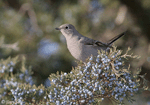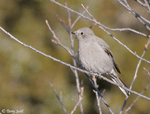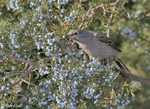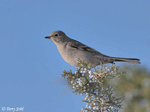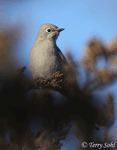| Length: 9 inches | Wingspan: 14 inches | Seasonality: Winter / All Seasons |
| ID Keys: White eye-ring, gray body and head, black tail with white edging visible in flight | ||
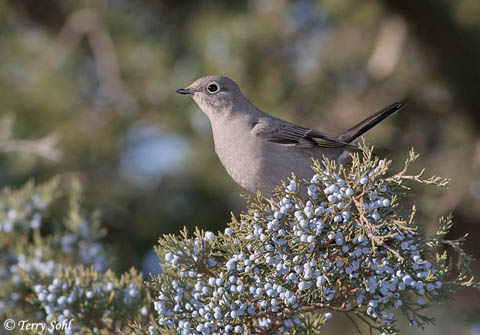 Usually seen alone (as the
name implies), Townsend's Solitaires are best known as winter visitors
throughout most of the state. Individual birds will aggressively defend a
patch of junipers or other sources of berries, with occasionally violent fights
breaking out between two birds.
Usually seen alone (as the
name implies), Townsend's Solitaires are best known as winter visitors
throughout most of the state. Individual birds will aggressively defend a
patch of junipers or other sources of berries, with occasionally violent fights
breaking out between two birds.
Habitat: Breeds in open conifer forest, requiring exposed rocky or dirt areas for nesting on the ground. In the winter, found in woodlands and shelterbelts, especially around junipers.
Diet: Primarily feeds on insects in the summer. Primarily feeds on fruits and berries in the winter, especially juniper berries.
Behavior: In summer, feeds by observing from a perch, and flying out to catch passing insects in mid-air, or pounce on ones spotted on the ground. They are also capable of fly-catching, capturing insects while in flight. Also feeds on berries by climbing and flitting through foliage.
Nesting: May through July. The nest of a Townsend's Solitaire is a cup of grasses, rootlets, moss, and other material, placed on the ground in a protected area, such as the base of a fallen log or clump of vegetation. The female lays between 4 and 7 eggs, and she does the majority of the incubation. The young hatch after about 2 weeks.
Song: Townsend's Solitaire song, also Townsend's Solitaire call note.
Migration: Lives in all seasons through most of the higher elevation Western U.S. Extends its range in summer through the Canadian Rockies up into Alaska. Extends its range in winter by moving to lower elevations in the West, and moving eastward.
Interactive eBird map: Click here to access an interactive eBird map of Townsend's Solitaire sightings
Similar Species: Northern Mockingbird
Conservation Status: Populations appear to be stable or increasing, they are found over a wide geographic area, and are common in parts of their range. The IUCN lists the Townsend's Solitaire as a species of "Least Concern".
Further Information: 1) USGS Patuxent Bird Identification InfoCenter, Townsend's Solitaire
2) WhatBird - Townsend's Solitaire
3) Audubon Guide - Townsend's Solitaire
Photo Information: November 24th, 2007 -- Near Pierre -- Terry Sohl
Additional Photos: Click on the image chips or text links below for additional, higher-resolution Townsend's Solitaire photos.
| Click on the map below for a higher-resolution view |
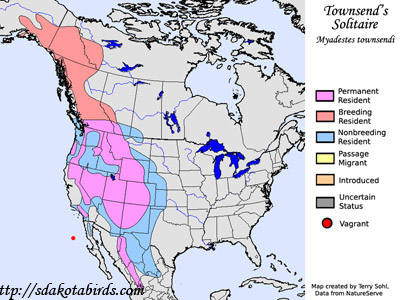 |
| South Dakota Status: Uncommon permanent resident in the Black Hills. Rare winter visitor elsewhere in the state. |
Additional Townsend's Solitaire Photos
Click for a higher-resolution version of these photos
